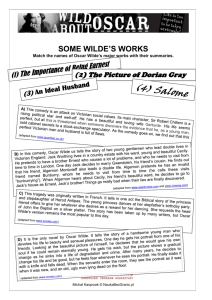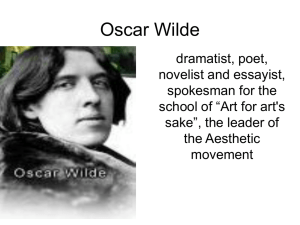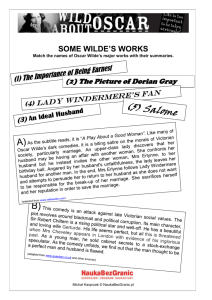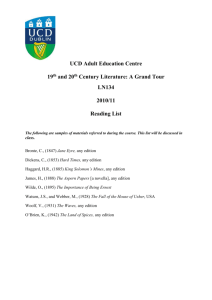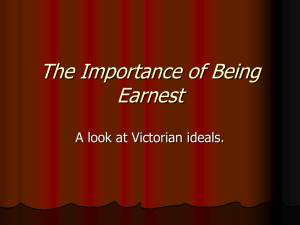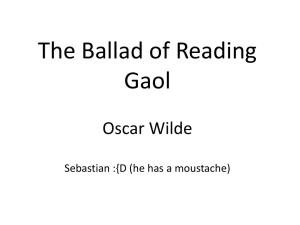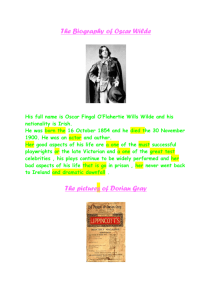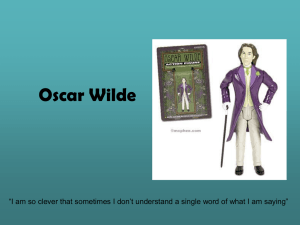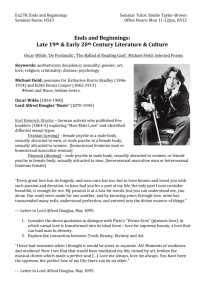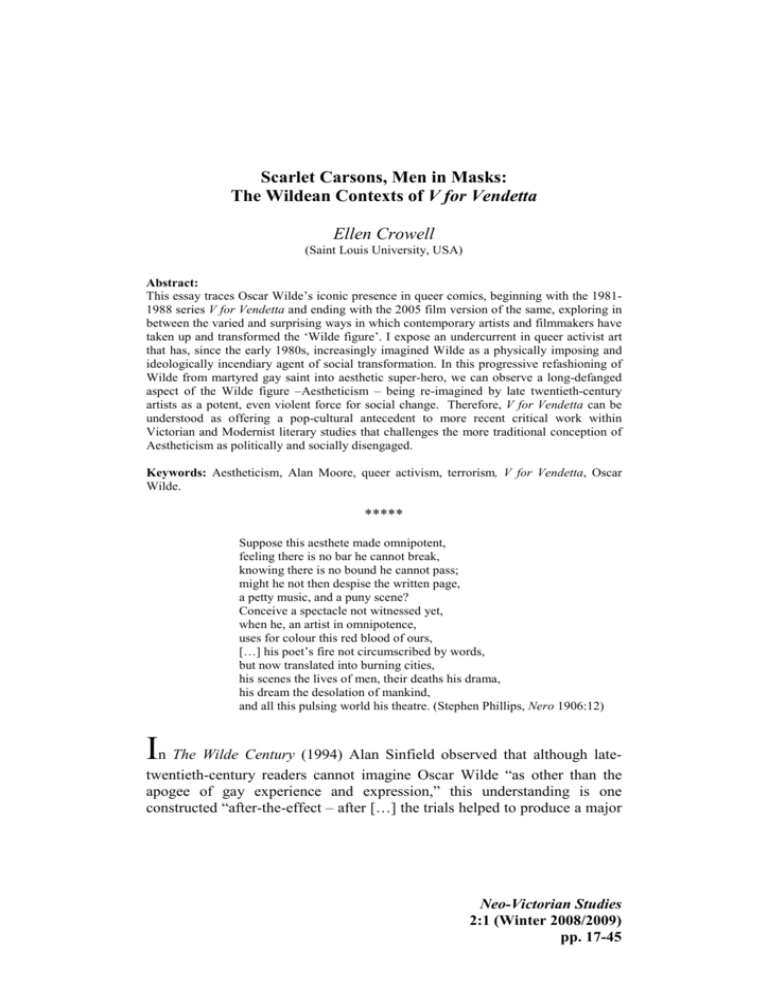
Scarlet Carsons, Men in Masks:
The Wildean Contexts of V for Vendetta
Ellen Crowell
(Saint Louis University, USA)
Abstract:
This essay traces Oscar Wilde’s iconic presence in queer comics, beginning with the 19811988 series V for Vendetta and ending with the 2005 film version of the same, exploring in
between the varied and surprising ways in which contemporary artists and filmmakers have
taken up and transformed the ‘Wilde figure’. I expose an undercurrent in queer activist art
that has, since the early 1980s, increasingly imagined Wilde as a physically imposing and
ideologically incendiary agent of social transformation. In this progressive refashioning of
Wilde from martyred gay saint into aesthetic super-hero, we can observe a long-defanged
aspect of the Wilde figure –Aestheticism – being re-imagined by late twentieth-century
artists as a potent, even violent force for social change. Therefore, V for Vendetta can be
understood as offering a pop-cultural antecedent to more recent critical work within
Victorian and Modernist literary studies that challenges the more traditional conception of
Aestheticism as politically and socially disengaged.
Keywords: Aestheticism, Alan Moore, queer activism, terrorism, V for Vendetta, Oscar
Wilde.
*****
Suppose this aesthete made omnipotent,
feeling there is no bar he cannot break,
knowing there is no bound he cannot pass;
might he not then despise the written page,
a petty music, and a puny scene?
Conceive a spectacle not witnessed yet,
when he, an artist in omnipotence,
uses for colour this red blood of ours,
[…] his poet’s fire not circumscribed by words,
but now translated into burning cities,
his scenes the lives of men, their deaths his drama,
his dream the desolation of mankind,
and all this pulsing world his theatre. (Stephen Phillips, Nero 1906:12)
In The Wilde Century (1994) Alan Sinfield observed that although latetwentieth-century readers cannot imagine Oscar Wilde “as other than the
apogee of gay experience and expression,” this understanding is one
constructed “after-the-effect – after […] the trials helped to produce a major
Neo-Victorian Studies
2:1 (Winter 2008/2009)
pp. 17-45
Ellen Crowell
18
_____________________________________________________________
shift in perceptions of the scope of same-sex passion” (Sinfield 1994: 2-3).
Sinfield’s study was one of the first to explore how this cultural event
guided the construction of an “Oscar Wilde type” in which an “entire,
vaguely disconcerting nexus of effeminacy, leisure, idleness, immorality,
luxury, insouciance, decadence and aestheticism […] was transformed into a
brilliantly precise image” (Sinfield 1994: 3). “Beautifully precise” because it
offered a template for the figure of the homosexual, a “type” which, Sinfield
argued, influenced and in fact limited twentieth-century attempts to define
and develop “radical lesbian and gay identities”:
The key question is: if we come to consciousness within a
language that is continuous with the power structures that
sustain the social order, how can we conceive, let alone
organize, resistance? If deviant identities are produced by the
dominant ideology in ways that police sexualities, containing
dissidence, how is a radical lesbian or gay identity to arise?
(Sinfield 1994: 15)
The Wilde Century, written against the backdrop of Thatcherite
conservatism, the outbreak and explosion of the AIDS epidemic, and queer
aesthetic/activist responses to both, concluded by exploring how gay and
lesbian activist groups in the 1980s and early 1990s, almost one hundred
years after the fact, continued to be limited in their ability to protest against
homophobic social structures by this Wildean legacy.
Discussing activist responses to Section 28 of the 1988 Local
Government Act, which prohibited the use of government funds for the
‘promotion’ of homosexuality and particularly affected British funding for
the arts, Sinfield writes:
The campaign was courageous, well organized and much
publicized, and arts celebrities came out. Astonishingly, at
first sight, this carried precious little weight with the
government and newspapers that supported it; the votes in
parliament were the same at the end of the campaign as at the
beginning. The reason, I believe, is that people in our
cultures already know that art is associated, stereotypically,
with male homosexuals. As I have said, the association of art
Neo-Victorian Studies 2:1 (Winter 2008/2009)
Scarlet Carsons, Men in Masks
19
_____________________________________________________________
and effeminacy has, up to a point, been dissident […] for
some purposes, our society credits this. However, art starts
off as the subordinate term in the masculine/feminine binary
structure, and from that position, always, it is very difficult to
make much headway. (Sinfield 1994: 190, original italics)
Anticipating that this position might draw critique from queer activist
groups like ACT UP, Queer Nation and OutRage, Sinfield argues that any
wariness on his part stems not from a reluctance to upset people, but from a
sense that “we cannot upset them enough.” Citing a 1991 flyer entitled
‘Queer Power Now’, which exhorted queer citizens to “Write some books.
Be Safe. Burn buildings. Shoot closets. Screw in the streets”, he observes
that of the advocated actions “only the attack on property would seriously
trouble the system, and when other groups try that the main outcome is an
increase in state surveillance and control” (Sinfield 1994: 203-204).
Therefore, for Sinfield, writing in the early 1990s, the truly radical aesthete
is a conceptual impossibility. Although The Wilde Century acknowledges
early on that “[i]n the dissidence encoded in aesthetic effeminacy, Wilde
saw his great opportunity” and that for a brief time Wildean aestheticism
succeeded in challenging “the manly purposefulness of industry and
empire” (Sinfield 1994: 89), this study ultimately seems to suggest that
because of the swift association of Wildean (or decadent) aestheticism with
a ruined, policeable type, the radical potency of queer art as protest – against
imperialism, materialism, and sexual conservatism – was profoundly
diluted.
Yet in that same 1991 flyer’s formulation of “queer power” we find
articulated the very combination of aesthetic (“write some books”) and
anarchic (“burn buildings”) sensibilities that animates the aesthete anti-hero
at the center of the graphic novel V for Vendetta. This series, written by
Alan Moore and illustrated by David Lloyd between 1981 and 1987 was
first serialised in the British anthology comic series Warrior and then by
D.C. Comics. Like Sinfield’s The Wilde Century, V for Vendetta was
composed against the backdrop of – and in direct response to – the
conservatism and state-sanctioned homophobia of Thatcher’s England.
However, Vendetta draws upon an alternative understanding of the aesthete
figure’s importance to contemporary queer activism. By transporting a lateVictorian history of radical aestheticism, homophobic conservatism, and
Neo-Victorian Studies 2:1 (Winter 2008/2009)
Ellen Crowell
20
_____________________________________________________________
queer imprisonment into a dystopian future in which the aesthete critiques
society not by turning away into art, but by turning art into a kind of
activist-terrorism, this text recovers (and transforms) an arguably common
and equivocal understanding of Wilde and Wildean aestheticism in broad
circulation during both the fin-de-siècle and the first decade of the twentieth
century: the aesthete as terrorist. In so doing, Vendetta uses the “beautifully
precise” image of Wilde in a way that uncovers a keen desire, emerging in
the 1980s and still developing today, for a kind of queer avenger figure, one
whose iconic embodiment of a queer past full of shame, abjection, and
denial might fuel, rather than impede, social change.
Set in what was, in 1981, the near-future fin-de-siècle of the late
1990s, Vendetta critiques Thatcherite conservatism by imagining London as
a post-nuclear dystopia in the grips of a neo-fascist regime. However, as this
essay will demonstrate, V for Vendetta also looks backward to the Victorian
fin-de-siècle, and to that same nexus of decadence, aestheticism, effeminacy
and immorality which Sinfield argues was then consolidated into a distinct
“Wilde type.” Although to some degree this graphic novel fits the generic
conventions of utopian/dystopian political fiction, its engagement with the
Wilde story and the politics of decadent aestheticism marks its narrative
orientation as past rather than future-oriented; much as Heather Love
observes of Sylvia Townsend Warner’s Summer Will Show (1936), its
“revolutionary imagination is bound not to the redeemed world but to the
damaged world that it aims to repair” (Love 2007: 132). V for Vendetta is,
in fact, a text that, to adapt Love’s terminology, feels backwards to look
forwards.
By imagining a past-oriented queer dystopia as the bedrock upon
which this critical engagement with the Victorian past would unfold, Moore
and Lloyd ushered in a strand of pop-cultural texts – beginning with the
Vendetta series, extending through the 1990s in underground comics, such
as Dave Sim’s Melmoth (1991) and Joe Lansdale’s Jonah Hex (1995), and
ending with the 2005 Warner Brothers film adaptation of Vendetta – that
focus upon the “dark affects that fuel social change” (Love 2007: 131), that
creatively reinterpret the decadent 1890s and Wilde himself as more
politically engaged, more revolutionary, more dangerous even, than could
be responsibly argued by any literary historian. Yet in this hyperbolic and
fantastical neo-Victorian landscape, we find vividly recuperated an
understanding of and response to Wilde and decadent aestheticism from the
Neo-Victorian Studies 2:1 (Winter 2008/2009)
Scarlet Carsons, Men in Masks
21
_____________________________________________________________
late-Victorian and debut de siècle period, which are only now being
reconstructed in Victorian, modernist, and queer studies.
In this way, V for Vendetta and the subsequent reworkings of the
Wilde figure that its Wildean anti-hero V inspired are ideal texts to consider
within the framework of Neo-Victorian Studies. By recovering, through
futuristic dystopia, a radical vision of decadent aestheticism and its
challenge to socio-political and cultural conservatism, such texts offer
scholars and students a “different way into the Victorians”, as Mark
Llewellyn argues, “not contemporary literature as a substitute for the
nineteenth century but as a mediator into the experience of reading the ‘real’
thing”; they connect with the past in surprising ways that “act out the results
of reading the Victorians and their literary productions” (Llewellyn 2008:
5).
This essay will trace how neo-Victorian texts recast the Wildean
aesthete as destructive rather than passive, avenger rather than one to be
avenged, demonstrating that in the underground British comic culture of the
1980s we find a new “Wilde type,” a figure transformed from martyred
artist and gay saint into a kind of aesthetic super-hero: a physically
imposing and ideologically incendiary agent of social transformation, who
enacts, rather than inspires, outraged vengeance.
1.
Aesthetic Terrorism
In the fall of 1895, after Oscar Wilde had been sent to prison for
gross indecency, the Echo advised readers to “forget all about Oscar Wilde,
his perpetual posings, his aesthetical teachings and his theatrical
productions. Let him go into silence, and be heard from no more” (qtd. in
Holland 1954: 268). In this brief passage we find swiftly illuminated two
responses to the cultural legacy of decadent aestheticism, which in fact work
in tandem: the Echo’s dismissal of Wilde and his work as superfluous and
dated is significantly undercut by the journal’s obvious and anxious interest
in rooting out these same aesthetical teachings, posings, and productions.
For despite the superior tone adopted here, to publicly advocate an artist’s
exile “into silence, to be heard from no more” is to paradoxically
acknowledge that artist’s absolute centrality, via aesthetic and ideological
threat, to the culture from which he or she is to be banished.
Of course, Wilde was never in danger of going “into silence,” even
after his death in November of 1900. In the first decade of the twentieth
Neo-Victorian Studies 2:1 (Winter 2008/2009)
Ellen Crowell
22
_____________________________________________________________
century, the importance of Wilde and Wildean aesthetics to modern
literature was a topic on which literary critics, artists, and theologians
weighed in with great frequency. In 1907, the Methodist Review published
a vitriolic posthumous attack on Wilde, entitled ‘The Consummate Flower
of Aestheticism’. Written in response to “an effort on the part of certain
intrepid champions of aestheticism to restore Oscar Wilde to public
tolerance and even favorable regard” (Anon. 1907: 451), this essay sees its
duty in “insist[ing] on the awful moral lessons which drip from the fate of
Oscar Wilde like drops of blood from a sharp chisel’s edge” (Anon. 1907:
452). These lessons are equivocal: Wilde is shown to be unfit for critical
rehabilitation because his philosophy of art is at once mere theory (entirely
sterile, limp and useless) and theory-in-action (supremely criminal,
anarchic, and terrorist). Lengthy harangues on Wilde’s iconic criminality,
like the one below, are routinely followed up with dismissive summations of
aestheticism’s complete inefficacy as a social movement:
A free community is always tolerant of mere theories,
however pernicious, immoral, or destructive; but when the
theorist puts his objectionable and injurious theories into
practice by overt acts, then he encounters the teeth of the
effective machinery which society maintains for its own
protection and which does not discriminate between aesthetes
and anarchists. […] Wilde lived his principles to the full, and
so he became the consummate flower of aestheticism.
Usually it is some weak-minded or unbalanced disciple of
destructive theories that is rash enough to perpetrate the
extreme overt act logically enjoined by the evil teaching. […]
But in the case of the aesthetes, those anarchists against the
moral law, it is their chief prophet, apostle, and teacher who
has the nerve, the reckless daring to practice what he
preaches and to live down to the principles they all uphold.
(Anon. 1907: 430)
For this writer, aesthetic theory itself is mere cultural irritation, whereas a
decadent aestheticism that materialises in “overt acts” negates any
distinction between aesthete and anarchist; the paragraph ends imagining
Wildean aestheticism as an embodied doctrine of cultural terrorism. Yet the
Neo-Victorian Studies 2:1 (Winter 2008/2009)
Scarlet Carsons, Men in Masks
23
_____________________________________________________________
very next line of this alarmist essay (which, it should be noted, imagines in
the present tense a cultural threat then safely dead for seven years) veers in
the opposite direction, dismissing this same public enemy as entirely limp
and ineffectual: “Nothing is plainer than the superficiality and futility of
aestheticism as a means of culture” (Anon. 1907: 430).
Hence, two warring conceptions of decadent aestheticism – as
passive, superficial, and futile versus active, covert, and anarchic –
structured responses to Wilde in the first decades of the twentieth century.
Another evocative reminder of Wilde’s posthumous double identity as
outmoded fop and public enemy can be found in Stephen Phillips’ 1906
drama-in-verse, Nero, which refashioned the famously decadent Roman
emperor into a recognisably Wildean aesthete-terrorist. Produced by and
starring Wilde’s theatrical associate Beerbohm Tree, the play depicted Nero
as an “aesthete made omnipotent” who, realising the terrible reach of his
own power, casts aside the world of art and takes as his canvas “all this
pulsing world” (Phillips 1906: 12-13). Both the timing of Nero’s premiere
in January, 1906, only months after the posthumous publication of Wilde’s
De Profundis, and the play’s stylistic affiliation with decadent symbolist
drama, ensured that Phillips’ evocation of a nihilist aesthete would be
expressly associated with Wilde.
Writing for the Saturday Review, Henry Hodge blasted Phillips’
style as unsuccessfully affected: “this play is killed by the monotonous
rhythm of the verse. Mr. Phillips has practically but one verse, a flaccid line,
producing a feeble sound like an untaut [sic] string of a violin” (Hodge
1906: 136). Hodge also singled out Phillips’ decadent “purple prose” for
pointed critique: “Nero is all purple […] if unvaried purple be the right hue,
the dye should have been better. Shabby purple has a mean effect […] why
cannot any of them speak to the point?” (Hodge 1906: 136) Although
Hodge’s review does not mention Wilde directly, his obvious (and
suggestively homophobic) distaste for both the artificial speech of symbolist
drama and the pointless extravagance of “purple prose” carries echoes of
other anxious and angry dismissals of decadent aestheticism in general and
Wilde in particular.
The New York Times was less oblique. Its drama critic Montgomery
Schuyler at once identified Nero with Wilde, in fact citing the very notion
that a Wildean figure could be capable of assuming cultural power as the
play’s chief dramatic shortcoming:
Neo-Victorian Studies 2:1 (Winter 2008/2009)
Ellen Crowell
24
_____________________________________________________________
The leit-motif of this present drama is, we will not say a
rehabilitation, but a “historical synthesis,” if that be the latest
expression, of the character of Nero. […] Nero here is a
degenerate aesthete, a late Roman Oscar Wilde, and the
famous “Qualix artifis pereo” might be the motif of the
tragedy. Oscar Wilde, “Imperator” or Augustus, is in fact Mr.
Phillips’ Nero. One must have his doubts. How any human
community could at any time have accepted that variety of
person as “serious,” let alone as a “ruler,” is one of those
things that the drama omits to make plain. (Schuyler 1906:
172)
Both Schuyler’s incredulity and Hodge’s preference for masculine
directness indicate the ascendance of that understanding of decadent (or
‘degenerate’) aestheticism as limply effeminate, imprecise, and incapable of
action, which permeated literary modernism and arguably persists in
vestigial form even today. Yet the very presence of a 1906 drama depicting
a recognisably Wildean aesthete-terrorist, or an article railing against the
“overt acts” that sever any distinction between aesthete and anarchist, attests
to more than the growing understanding of Wildean aestheticism, during the
first decades of the twentieth century, as apolitical, sterile, and ‘effeminate’,
as antithetical to the progress of modern art and political thought. It also
reminds us that, to some extent at least, this understanding has been
retrofitted upon a movement that was just as commonly understood to be
supremely – and dangerously – engaged.
Although, as Ann Ardis has persuasively demonstrated, by 1914
cultural attitudes towards decadent aestheticism and the figure of the
aesthete had largely shifted from alarmist to dismissive, these examples
reveal that as late as 1907 the Wildean type provoked as much outrage as
condescension. Recent scholarship in Victorian, Modernist and Queer
studies that recovers a “turn-of-the-twentieth century cultural landscape in
which modernism did not (yet) throw gigantic shadows” offers a revised
understanding of the socialist, utopian, even revolutionary politics of
decadent aestheticism (Ardis 2002: 4). Elizabeth Miller’s work on William
Morris, for instance, challenges critics to understand Morris not as either “a
socialist trapped in the Aesthetic age, or an Aesthete mired down in socialist
propaganda” (Miller 2008: 477), but instead as a figure crucial to
Neo-Victorian Studies 2:1 (Winter 2008/2009)
Scarlet Carsons, Men in Masks
25
_____________________________________________________________
understanding the continuities between Aestheticism and revolutionary
socialism. Similarly, Ardis argues that the conspicuous omission of Wilde in
early avant-garde modernism’s “creation of a usable past [as] a key means
of […] coming to terms with […] the alleged chaos of the modern world” in
fact speaks volumes about Wilde’s haunting presence within the movement
as “an ambiguously-gendered father figure whose paternity is dangerous to
claim” (Ardis 2002: 47). Cassandra Laity too traces a Wildean geneology of
influence, observing that, as scholars begin to challenge decadent
aestheticism’s “alleged detachment from socio-political reality,” we are
increasingly able to create “new Decadent-to-modern trajectories engaging
cultural studies – visual, material, popular – and/or socio-political theories
of flux, nature, the body, ‘utopia,’ race, gender, and sexuality” (Laity 2008:
427-428). However, as the sections that follow will show, such important
critical work expands rather than inaugurates this reassessment. For in the
neo-Victorian landscape of V for Vendetta we find anticipated his very trend
in critical approaches to decadent aestheticism, modernism, and Wilde
himself.
2.
V for Vendetta: The Series
In 1975, when Alan Moore was twenty-two years old, he entered a
D.C. Thomson talent competition with what was, for its time, fairly
explosive comic book material: “My idea concerned a freakish terrorist in
white-face makeup who traded under the name ‘The Doll’ and waged war
upon a totalitarian state” (Moore 1998a: 268). The competition judges
“decided a transsexual terrorist was not quite what they were looking for,”
and Moore recounts how “faced with rejection I did what any serious artist
would do. I gave up” (Moore 1998a: 268). Not for long, though. Five years
later, with ‘The Doll’ figure still ranging around in his psyche, Moore
teamed up with the artist David Lloyd to create a comic series set in the then
near future of the late 1990s, in an England ruled by a fascist regime hostile
to all individuals it deemed ‘outsiders’. Reflecting on the process both went
through to create their vigilante antihero ‘V,’ Moore identified the mélange
of cultural and literary influences that eventually coalesced, in 1981, into
this dark figure:
One night, in desperation, I made a long list of concepts that
I wanted to reflect in V, moving from one to another with a
Neo-Victorian Studies 2:1 (Winter 2008/2009)
Ellen Crowell
26
_____________________________________________________________
rapid free-association that would make any good psychiatrist
reach for the emergency cord [….] Huxley. Orwell. Vincent
Price. David Bowie. Max Ernst’s Europe after the Rains.
Thomas Pynchon. Robin Hood. (Moore 1998a: 270)
In this list, we see artists whose work informs the kind of post-apocalyptic
landscape that would emerge as the backdrop for the series, as well as
figures who evoke the kind of vigilante justice meted out by the anti-hero at
its center. Bowie, of course, was imagined as Wilde’s affective descendant
in Todd Haynes’ 1998 film Velvet Goldmine, while Vincent Price enjoyed
renewed fame for his portrayal of Wilde in the hugely-successful one-man
show Diversions and Delights in the late 1970s. Both retain the elements of
radical androgyny and dandyish aestheticism that Moore first envisioned for
his “freakish terrorist” (Moore 1998a: 268).
David Lloyd responded to this surreal mix of androgynous anarchy
with what would become the definitive addition:
Why don’t we portray him as a resurrected Guy Fawkes,
complete with one of those papier-mâché masks, in a cape
and a conical hat? He’d look really bizarre and it would give
Guy Fawkes the image he’s deserved all these years. We
shouldn’t burn the chap every Nov. 5th but celebrate his
attempt to blow up Parliament! (“Painted Smile” 272)
Without the Bowie/Price infusion carried forward from ‘The Doll’, the
image of an anti-hero in mask, cape and conical hat might read fairly
straightforwardly as a Fawkes reference. But with this dandified, decadent
addition, the V that emerged first in the series and later in the film version
of Vendetta also reads as a futuristic visual citation of Napoleon Sarony’s
1882 portraits of the twenty-eight-year-old Oscar Wilde, dressed in his
signature ‘aesthetical’ costume of his early career, with the addition of a
stylised mask that cites and makes literal the cornerstone of Wilde’s critical
and aesthetic philosophies: “Man is least himself when he talks in his own
person. Give a man a mask, and he will tell you the truth” (Wilde 2007:
185). And by recuperating a pre-modernist understanding of Wilde as
societal threat and potent anti-hero, Vendetta was poised to give Wilde, like
Fawkes, “the image he’s deserved all these years”.
Neo-Victorian Studies 2:1 (Winter 2008/2009)
Scarlet Carsons, Men in Masks
27
_____________________________________________________________
Figure 1: Napoleon
Sarony, “Oscar Wilde”
1882, reprinted with
kind permission from
the United States
Library of Congress.
Figure 2: From V for
Vendetta © 1988 DC
Comics.
Figure 3: From V for
Vendetta © 2005 Warner
Brothers.
All Rights Reserved.
All Rights Reserved.
In 1981, his mask firmly in place, the character V burst on the comic
book scene. Against the surreal backdrop of a post-apocalyptic London, this
decadent aesthete-vigilante swoops into the narrative just in time to save the
life of a young prostitute named Evey before proceeding to the more critical
objective of his evening – blowing up the houses of parliament – all the
while quoting Shakespeare’s Macbeth and a familiar folk rhyme demanding
all “remember, remember, the fifth of November, the Gunpowder treason
and plot.” Evey is witness to this event, the pyrotechnics of which she
admires as “so beautiful…” (Moore and Lloyd 1988: 11-14); thus, her
series-long apprenticeship as aesthete-terrorist begins.
In these first pages, Vendetta announces itself as a comic series
actively dismantling the common association of art and passivity,
Neo-Victorian Studies 2:1 (Winter 2008/2009)
Ellen Crowell
28
_____________________________________________________________
challenging popular dismissals of art “as the subordinate term in the
masculine/feminine binary structure” (Sinfield 1994: 190). This narrative
focus only becomes clearer as the series develops. In Book One, Europe
After the Reign, we witness an anti-hero equally well-versed in literature and
explosives blow up governmental buildings in an aesthetically-pleasing
way, after which he transports his apprentice to a subterranean cultural
archive, his “Shadow Gallery”, where he houses all works of art censored
and outlawed by the regime in power. Young enough to have lived her
whole life in ignorance of the paintings, sculptures, compositions and books
preserved in this underground gallery, Evey must ask: “Are we still in
London? […] It’s unbelievable! All of these paintings and books […] I
didn’t even know there were things like this.” To which V replies: “You
couldn’t be expected to know. They have eradicated culture. Tossed it away
like a fistful of dead roses.” (Moore and Lloyd 1988: 18) The dead roses
referred to here are emblematic, both of lost aesthetic cultures in general and
of particular artists exterminated by the government: in the final chapter of
book one, ‘The Vortex’, we find out that V, along with many others
including a lesbian actress named Valerie, was imprisoned, experimented
upon, and tortured at Larkhill, a “resettlement camp” for detainees deemed
societal deviants.
Readers are never told exactly why V was imprisoned there; the text
offers several clues based firmly in cultural stereotype, only to swiftly turn
those stereotypes on their heads. A series of panels records one Larkhill
doctor’s notes on the man in room five:
The man in room five is a really fascinating case. Physically,
there doesn’t seem to be anything wrong with him. No
cellular abnormalities, nothing. But he’s quite insane. […]
Strangely, he’s developed one of those curious side effects
which seem to afflict certain categories of the schizophrenic:
His personality has become totally magnetic. He says very
little […] but there’s something about the way he looks at
you. He looked at me today as if I were some sort of insect.
He looked at me as if he felt sorry for me. His face is very
ugly. I’ve been thinking about it all day. (Moore and Lloyd
1988: 81)
Neo-Victorian Studies 2:1 (Winter 2008/2009)
Scarlet Carsons, Men in Masks
29
_____________________________________________________________
The “strange magnetism” of V’s personality, which fascinates without
words and attracts with an ugliness so arresting it functions as beauty, is
translated and made more acceptable to his captors through his proficiency
for the domestic arts. This magnetic prisoner is allowed to work in the
facility gardens, and under his green thumb crop production doubles. The
same doctor observes that “Room Five” is now allowed to order his own
garden materials; he has been given “a patch to grow flowers on. He grows
roses, beautiful roses.” (Moore and Lloyd 1988: 81). These roses are
immediately associated with cruelty and suffering, as this rhapsodic praise
of V’s horticultural yield is followed immediately with the observation,
“The woman in room one died this morning. The skin on her face and neck
was like polythene.” (Moore and Lloyd 1988: 81) After his success at
gardening, V asks to be employed as an interior decorator; the next panel
records, “Sept. 18th. Garden doesn’t require much work this time of year.
Room Five wants to help with the decorating in the staff quarters.” (Moore
and Lloyd 1988: 81)
Here, the accumulation of cultural stereotype encourages readers to
assume that the aesthete vigilante of Vendetta’s opening pages has been
imprisoned for sexual deviance – he is, after all, both an excellent gardener
and a gifted interior decorator. But if Vendetta’s readers understand V as a
queer character based upon the stereotypes the narrative recycles to facilitate
such a deduction, then as Wilde wrote in The Importance of Being Earnest:
“The truth is rarely pure and never simple.” (Wilde 2000: 362) The woman
in room one, we later find out, was Valerie – an actress imprisoned for
being a lesbian, who consoled herself in the face of death by remembering
the roses she and her lover grew together in their London garden. V’s foray
into the domestic art of gardening served two non-stereotypical purposes: he
grew roses in silent, outraged communion with Valerie, and he used his post
as prison gardener to order copious amounts of garden fertiliser. Then, as
Larkhill’s interior decorator, he ordered various paints and solvents that,
combined with garden fertiliser, produce explosive results: “I was in the
Mess. It was about half-past ten when I heard the explosion. […] I couldn’t
have known […] the ammonia, the grease solvent and all the other stuff.
He’d been making things with them. Mustard gas.” (Moore and Lloyd 1988:
83) In this complex series of panels, readers curious about V’s background
are seduced into thinking that they, like the officials at Larkhill, can ‘type’
Vendetta’s anti-hero and thus understand his vendetta against an
Neo-Victorian Studies 2:1 (Winter 2008/2009)
Ellen Crowell
30
_____________________________________________________________
incarceratory homophobic society. But such thinking is swiftly undercut. V
is revealed to have used the stereotypical association between aesthetic
proficiency and passivity to his destructive advantage. Readers are placed in
the shocked position of V’s captors. Alan Moore, like V himself, deploys
homophobic stereotypes, including the association of art with passivity, to
explode them.
V for Vendetta ran for seven years. As the series evolved, its use of a
late-Victorian affective landscape, as a bedrock upon which to stage its
response to increasingly conservative policies regarding ethnic and sexual
minorities, became more complexly intertextual. By Chapter 11, titled
‘Valerie’, the incarceration and state-sponsored murder of homosexuals is
imagined as the ultimate outrage through which terrorist consciousness is
created and transmitted. To transform his apprentice into a fearless enemy of
the state, V creates a false prison – a virtual Larkhill – in which Evey herself
is incarcerated and tortured. Just when her will is almost shattered, she finds
steely resolve in a letter pushed through a hole in her cell wall. This
autobiographical letter, written (so Evey believes) by an imprisoned lesbian
named Valerie, records, preserves, and viscerally evokes a queer English
past, one that cannot be eradicated by prison, torture, or exile. Evey emerges
from her prison ordeal transformed by this letter, as did V before her – for
she learns that although her imprisonment was an elaborate trick, the letter
was real. The letter V passes to Evey is the same that was passed to him at
Larkhill, the one that inspired him to plant roses and explode Mustard gas in
Valerie’s honour. Thus, the same letter facilitates both characters’
transformation from victim to vigilante. Valerie’s letter is the decisive
propaganda – a queer epistolary autobiography turned countercultural
weapon.
Of course, the idea that queer epistolary autobiography can be
wielded as a countercultural weapon is not new to readers of Wilde.
Although Wilde began the twentieth century as a pariah, by mid-century he
was beginning to be embraced as victim and martyr. This transformation
was facilitated in part by the piecemeal process whereby unexpurgated
versions of Wilde’s letters from prison and after, including the lengthy and
controversial De Profundis, became available to the public. It was not until
1962 that Rupert Hart-Davis published unexpurgated versions of Wilde’s
late letters (including a mostly-complete version of De Profundis), in which
the writer detailed the abuses he suffered both in prison and in exile before
Neo-Victorian Studies 2:1 (Winter 2008/2009)
Scarlet Carsons, Men in Masks
31
_____________________________________________________________
dying in Paris in 1900. These letters played a large role in the
transformation of Wilde from ultimate pariah and public menace at the start
of the twentieth century into an object of pity and the first “gay martyr”
towards its end. V for Vendetta’s use of the queer prison letter as vehicle for
political transformation can therefore be understood as a provocative echo
of Wilde’s De Profundis and its potent afterlife in the history of queer
activism – an afterlife vividly remembered in the purple gothic script of a
protest badge from the early UK gay rights movement, shown below.
Figure 4: “Avenge Oscar Wilde”. Artist unknown.
Reproduced with kind permission from the Lesbian and Gay
Newsmedia Archive (LAGNA).
V’s acts of vengeance, inspired by a letter from the past, transform V for
Vendetta’s futuristic fascist dystopia into a neo-Victorian narrative that
remembers Wilde to dramatise a trans-historical queer activism, in which
one aesthete’s martyrdom inspires future acts of civil disobedience.
3.
“I’m A-Go Wilde on You!”: The Evolving Wilde Type
In the same year V for Vendetta’s final installment appeared, Richard
Ellmann published his still-definitive biography, Oscar Wilde (1987), a
version of the Wilde story that, despite many acknowledged gaps and
misconstructions, was the first to illustrate the full spectrum of threats
Wilde, his works, and his persona posed to firmly-entrenched Victorian
ideological systems. For, like Vendetta’s V, Ellmann’s Wilde is not a
Victorian victim or martyr, but an iconic harbinger of modernity. The
Neo-Victorian Studies 2:1 (Winter 2008/2009)
Ellen Crowell
32
_____________________________________________________________
biography’s commercial success meant that many for the first time
understood Wilde as active rather than passive, vengeful rather than
requiring vengeance, physically imposing rather than retiring, a man with
justified resentments against the moralistic, theocratic, judicial system that
destroyed his career – a man, in short, who might understandably harbor
multiple vendettas. Ellmann’s documentary emphasis, greater than any
previous biographer’s, on Wilde’s physical and mental suffering during his
imprisonment, exile, and painful death in Paris, viscerally depicted the
consequences of legislative homophobia, transforming the Wilde story into
a narrative of martyrdom with clear implications for twentieth-century
activists.
Ellmann’s understanding of aestheticism in this biography
complements that which emerges in V for Vendetta. In his introduction,
Ellmann characterises Wilde as having “conduct[ed], in the most civilized
way, an anatomy of his society, and a radical reconsideration of its ethics”
(Ellmann 1987: xvi), and in a later chapter he expands upon this
characterisation of an uncompromising aestheticism:
Wilde balances […] two ideas which look contradictory: one
is that art is disengaged from life, the other is that it is deeply
incriminated with it. That art is sterile, and that art is
infectious, are attitudes not beyond reconciliation. Wilde
never formulated their union, but he implied something like
this: by its creation of beauty art reproaches the world,
calling attention to the world’s faults by disregarding them,
so the sterility of art is an affront or a parable. Art may also
outrage the world by flouting its laws or by indulgently
positing their violation. Or art may seduce the world by
making it follow an example which seems bad but is really
salutary. In these ways the artist moves the world towards
self-recognition, with at least a tinge of self-redemption, as
he compels himself to the same end. (Ellmann 1987: 329)
An Aestheticism which imagines art as a form of direct action through
inaction, which by implication understands the aesthete as a sociallyengaged anarchic prophet, seems incompatible with the aloof ‘art for art’s
sake’ soundbite that echoes in many people’s heads in response to the word
Neo-Victorian Studies 2:1 (Winter 2008/2009)
Scarlet Carsons, Men in Masks
33
_____________________________________________________________
‘aesthete.’ And it is just this sense of aestheticism’s supreme
disengagement, its social passivity, that V for Vendetta effectively and
hyperbolically dismantled.
As he was completing Vendetta, Moore reflected upon the England
in which he now found himself working:
It’s 1988 now. Margaret Thatcher is entering her third term
of office and talking confidently of an unbroken
Conservative leadership well into the next century. […] the
tabloid press are circulating the idea of concentration camps
for persons with AIDS. The new riot police wear black
visors, as do their horses, and their vans have rotating video
cameras mounted on top. The government has expressed a
desire to eradicate homosexuality, even as an abstract
concept, and one can only speculate as to which minority will
be the next legislated against. I’m thinking of […] getting out
of this country soon [.…] I don’t like it here anymore.
(Moore 1988b: 6)
Rather than leave, however, Moore worked with a group of likeminded
artists on a collection entitled A.A.R.G.H. – Artists Against Rampant
Government Homophobia. This 1988 publication constitutes an artistactivist response to Section 28 of the Local Government Act which, as
earlier noted, Alan Sinfield also discussed. The creative manifesto
interestingly echoes and expands upon the themes and imagery of Vendetta.
Neil Gaiman’s contribution, a panel entitled ‘From Homogenous to Honey’,
imagines a spokesperson for an apocalyptic “new universe” who, concealed
behind a Vendetta-esque mask, embarks upon a systematic purgation of all
homosexual culture. Standing in front of a placard announcing a
performance of Wilde’s The Importance of Being Earnest, the masked
spokesman pauses to observe that “the presentation of plays by mollies and
tribadites encourages people to see them in a positive light, especially if
they’re any good”, before turning his machine gun upon Lady Bracknell and
Earnest Worthing just as they begin the famous “handbag” exchange
(Gaiman 1998: 45).
Neo-Victorian Studies 2:1 (Winter 2008/2009)
Ellen Crowell
34
_____________________________________________________________
Figure 5: Detail, “From Homogenous to Honey”.
Reproduced with kind permission from Neil Gaiman.
Moore’s own contribution to A.A.R.G.H., a long poem entitled ‘The Mirror
of Love’, likewise imagines Wilde as central to queer history. Whereas
Wilde is mock-denounced in Gaiman’s comic as particularly insidious,
precisely because of his influential canonisation and proven staying power,
he becomes an outright historical martyr central to Moore’s poem.
Although in both instances, Wilde is cast as a victim of homophobic
legislation, we can nonetheless note here a queer comic subculture
persistently utilising an iconography of Victorian martyrdom to politicise
the art and activism of the present – an iconography with Wilde at its
affective center.
By the mid-1990s Wilde seemed to be showing up everywhere in
popular culture. In 1991 Dave Sim, who worked with Moore on A.A.R.G.H.,
published Melmoth, a graphic novel that draws upon Wilde’s own letters, as
well as letters written among friends recording his death, to visualise the
artist in his dramatic last days at the start of the twentieth century. In 1995,
the comic series Jonah Hex introduced a volume entitled Wilde's West in
which the Irish aesthete is shown to be equally well-versed in hand-to-hand
combat as in aesthetic theory:
Wilde: Art! Music! Poetry! These are the juices of our souls!
Cowboy: Pardon me, English feller […] But you ain’t makin no
sense.
Neo-Victorian Studies 2:1 (Winter 2008/2009)
Scarlet Carsons, Men in Masks
35
_____________________________________________________________
Reckon them pants of yours have done mashed your knobs
so tight you’re talkin’ out of your head.
Wilde: Perhaps, sir. But at least I have the knobs to be mashed.
[Wilde-instigated, Wilde-dominated brawl ensues.]
(Lansdale 1995: 28)
Figure 6: Detail, from “Jonah Hex: Riders of the Worm and
Such” #2 © 1995 DC Comics. All Rights Reserved.
Alan Moore also wrote storylines for several comics after Vendetta that use
the 1890s and Wilde himself as direct points of reference, creating first the
comic series From Hell (1991-1996) in which Wilde appears as a minor
character populating Jack the Ripper’s London, and then The League of
Extraordinary Gentlemen (1999 and ongoing), the 2003 film version of
which imagines Wilde’s most iconic creation, the decadent Dorian Gray, as
an aesthete superhero. Such frequent invocation of Wilde and Wildean
contexts on the part of Moore and other graphic artists finally inspired
parody. In the June 1997 issue of Toyfare Magazine, an enraged Wilde
accuses Moore of willful misquotation (“I never said that!”), an accusation
which prompts an epic battle in which Oscar, wielding an ivory-tipped
walking stick with ninja-esque dexterity, proclaims, “I’m a-go Wilde on
you!” (Toyfare 1997: 13)
Neo-Victorian Studies 2:1 (Winter 2008/2009)
Ellen Crowell
36
_____________________________________________________________
Figures 7: Detail, from Twisted Toyfare Theater 106. Reproduced with
kind permission from Wizard Entertainment.
The Wilde emerging in these later comics is the Wildean persona
both V for Vendetta and Ellmann’s biography helped to create: selfpossessed, aggressively strong when necessary, willing to fight to protect
both his person and his aesthetic persona. Together, these late twentiethcentury popular transformations of the Wilde story underscore its stilltransformative cultural power and follow the general trend away from
vengeance for towards vengeance from the Wilde figure.
4.
V for Vendetta: The Film
As the latest installment in this trend, the 2005 film version of V for
Vendetta, directed by James McTeigue and starring Hugo Weaving, Natalie
Portman, Stephen Rea, and Stephen Fry, seems to more consciously
foreground the connections between the aesthetics of vengeance of V and
Wilde. In particular, the film builds upon and further highlights parallels
present in the Moore/Lloyd series between Valerie’s imprisonment and
Neo-Victorian Studies 2:1 (Winter 2008/2009)
Scarlet Carsons, Men in Masks
37
_____________________________________________________________
prison autobiography and the historical antecedent of Oscar Wilde’s own
prison experience. Although this scene forms the emotional climax of both
comic and film, other key alterations made at the character and plot levels
mark the film’s depiction of this moment of transformation as distinctly,
instead of vaguely, Wildean.
First, the scriptwriters alter the original opening in two key ways. In
the comic version, V enters quoting Shakespeare, proclaims himself “the
king of the twentieth century”, and then dispatches with talk in favour of the
business at hand: blowing up the Houses of Parliament (Moore and Lloyd
1998: 13-14). In the film version, this first scene takes pains to demonstrate
V’s equal dexterity with weapons and wit – his command of language and
his penchant for paradox are the first elements we identify in his character.
His sonorous voice flows from behind his mask, and suddenly the mask
proves more evocative of the paradox-wielding Wilde than Guy Fawkes – a
mask which, as V’s later insists, hides “more than flesh. Beneath this mask
is an idea” (McTeigue 2005).
Evey: Who are you?
V:
Who? Who is but the form following the function of
what. And what I am is a man in a mask.
Evey: Well I can see that.
V:
Of course you can. I am not questioning your powers
of observation, I am merely remarking upon the
paradox of asking a masked man who he is.
Evey: Oh. Right.
V:
But on this most auspicious of nights, permit me then,
in lieu of the more commonplace soubriquet, to
suggest the character of this dramatis persona. Voila!
In view, a humble vaudevillian veteran, cast
vicariously as both victim and villain by the
vicissitudes of fate. (McTeigue 2005)
In the film’s version of Vendetta, V– as well-versed in musical theater as in
aesthetic theory – invites Evey up to a “concert” on the rooftops
overlooking the Old Bailey courthouse and its motto, carved in stone,
promising to “punish the wrongdoer”: “A more perfect stage,” he observes,
“could not be asked for.” In the graphic novel version, V destroys the
Neo-Victorian Studies 2:1 (Winter 2008/2009)
Ellen Crowell
38
_____________________________________________________________
Houses of Parliament in this opening scene; only later does he destroy the
Old Bailey as his second, dramatic architectural decimation, leading towards
the ultimate target of 10 Downing Street. The film alters this narrative
progression, depicting instead a long-haired, paradox-wielding man in a
mask, who chooses the site where Oscar Wilde was tried and convicted in
1895 as the perfect one upon which to unleash an impeccably-staged act of
vengeance against state-sponsored hatred:
Evey:
V:
Evey:
V:
It’s beautiful up here.
A more perfect stage could not be asked for.
I don’t see any instruments.
Your powers of observation continue to serve you
well. But wait! It is to Madame Justice that I dedicate
this concerto, in honor of the holiday she seems to
have taken from these parts, and in recognition of the
impostor that stands in her stead. Tell me, do you
know what day it is, Evey?
Evey: Uh, November the 4th? [midnight bells chime]
V:
Not anymore. (McTeigue 2005)
More dramatically even than the opening chapter of the graphic novel
version, this opening scene codes V as an aesthete-terrorist in the Wildean
mode, committed to preserving – in his sartorial choices, paradoxical
conversation, even his explosive stagecraft – the art, music, literature, and
cultural traditions deemed decadent and destructive by a theocratic regime
reminiscent of the worst excesses of Victorian morality.
If, perhaps, this silver screen connection between the terrorist V and
Oscar Wilde still seems like a stretch, consider another change to the story
calculated to recall Wilde. In the graphic novel, a morally conflicted Evey
flees V and his Shadow Gallery, seeking refuge at the home of a man named
Gordon. In the original story, Gordon is a minor figure, present only to
advance Evey’s character arch: he offers Evey refuge and the two become
lovers only hours before Gordon is killed by members of an underground
mafia. In the film version, however, Gordon is a character central to both
plot and theme. The cinematic Gordon, played by Stephen Fry, is a closeted
gay satirist who enjoys a successful career as a television personality –
famous for poking fun at English culture just enough to entertain himself
Neo-Victorian Studies 2:1 (Winter 2008/2009)
Scarlet Carsons, Men in Masks
39
_____________________________________________________________
and his public, yet still avoid censure. The choice to rewrite Gordon as a
celebrity satirist and secret homosexual who, by keeping his own Shadow
Gallery of banned books, photographs and paintings, stands as a clear
double for the anarchic V, becomes distinctly rather than vaguely Wildean
through casting. For this altered character, of course, is played by Fry,
himself an out gay actor whose pitch-perfect portrayal of Oscar Wilde in the
1997 film Wilde earned him a Golden Globe nomination. Hence, the
alteration to the original story draws clear parallels between Fry’s outlaw
Gordon and the Wilde story.
When, in the first part of the film, Evey is introduced to V’s Shadow
Gallery, she exclaims, “God, if they ever found this place […]” to which V
replies, “I suspect if they do find this place, a few bits of art will be the least
of my worries” (McTeigue 2005). Gordon’s Shadow Gallery likewise
preserves those examples of visual art, literature, religion, and sexual life
banned by the current regime. When Evey, seeking refuge from both the
police and from V, arrives at Gordon’s posh London home, she is let into
his secret, Gordon reassures Evey with words that directly echo the film’s
first Shadow Gallery scene:
Evey:
Gordon, I know every cop in the country is
looking for me. I know it’s horrible of me to come
here, to put you in this situation. If they find me
here, you could be in terrible trouble!
Gordon: Evey, if the police ever searched my house you
would be the least of my problems. You trusted
me […] it would be terrible manners for me not to
trust you. (McTeigue 2005)
Opening a secret passage in a back wall, Gordon exposes a room full of
banned books, paintings, and photographs – some depicting naked men in
various sexual situations. Evey’s sudden quiet comprehension of Gordon’s
own criminal status, both aesthetic and sexual, is met with a brief
monologue from Gordon/Fry that, in its focus on sexuality, criminality, and
masks, resonates in interesting ways with the 1997 Wilde biopic:
You see, we’re both fugitives in our own way. You’re
wondering why you were invited here to supper in the first
Neo-Victorian Studies 2:1 (Winter 2008/2009)
Ellen Crowell
40
_____________________________________________________________
place if my appetites were for less conventional fare.
Unfortunately, a man in my position is expected to entertain
young and attractive ladies like yourself. Because, in this
world, if I were to invite who I desired, I would undoubtedly
find myself without a home, let alone a television show. […]
The truth is, after so many years, you begin to lose more than
just your appetite. You wear a mask for so long, you forget
who you were beneath it. (McTeigue 2005)
Both V and Gordon are, like Wilde, wearers of masks. Gordon is undone
when he, like Wilde, uses art to push the limits of social and political
critique and miscalculates both the reach of his fame and the reach of the
law: after throwing out an ‘approved script’ to instead lampoon the
government on national television, he is arrested in his home. His Shadow
Gallery exposed, Gordon is swiftly imprisoned and executed for his multiple
crimes against the state.
Evey, too, is captured and imprisoned, and told she must reveal the
location of the terrorist or be executed herself. She resists. In between
scenes depicting interrogation and torture, we watch as Evey reads and is
transformed by a letter she finds hidden in the walls of her prison cell. This
letter, written (as in the comic series) by a lesbian actress named Valerie,
juxtaposes memories of artistic triumph and romantic fulfillment with
visceral descriptions of a tortured, imprisoned present. This rhetorical
structure is underscored by the images that accompany the letter: we watch
Valerie’s past unfold in soft, golden focus, only to have the scene shift back
to Evey, dressed in prison garb with her head shaved, tortured and
interrogated before being thrown back into her cell where she recommences
reading Valerie’s letter. This back-and-forth movement between images of a
beautiful past and a horrible present amplifies what this essay has already
shown to be the significant connections between Vendetta’s use of the letter
from prison and Wilde’s De Profundis.
Wilde’s letter, like the film’s depiction of Valerie’s story, veers
wildly between memories of past artistic and romantic triumphs and present
ignominious suffering, and finally coalesces into a spiritual autobiography
of sorts, in which one finds shame, anger, and hatred replaced with a poetics
of suffering, humility, and ultimately, love:
Neo-Victorian Studies 2:1 (Winter 2008/2009)
Scarlet Carsons, Men in Masks
41
_____________________________________________________________
I have lain in prison for nearly two years. Out of my nature
has come wild despair; an abandonment to grief that was
piteous even to look at; terrible and impotent rage; bitterness
and scorn; anguish that wept aloud; misery that could find no
voice; sorrow that was dumb. I have passed through every
possible mood of suffering. […] Now I find hidden
somewhere away in my nature something that tells me that
nothing in the whole world is without meaning, and suffering
least of all. That something hidden away in my nature, like a
treasure in a field, is humility. It is the last thing in me, and
the best: the ultimate discovery at which I have arrived, the
starting-point for a fresh development. […] Of all things it is
the strangest; one cannot give it away and another may not
give it to one. One cannot acquire it except by surrendering
everything that one has. It is only when one has lost all
things, that one knows that one possesses it. (Wilde 2005:
96)
Of course, Wilde’s new life after being released from prison in 1897 was not
the Vita Nuova he hoped for; disgraced, impoverished, forcibly separated
from his wife and children, depressed and unable to write, Wilde lived only
three more years before dying at the age of forty-six in a small Paris hotel. It
was his De Profundis (originally entitled by Wilde before his death as
Epistola: in carcere et vinculis), initially published in a highly expurgated
form by his closest friend and literary executor Robert Ross in 1905 but not
revealed in its entirety until 1962, that became the gateway through which
Wilde’s literary reputation could be rehabilitated – a posthumous, martyred
voice ‘from the depths’, perfectly packaged to entrance and galvanise future
generations.
In the film version of V for Vendetta, Valerie’s letter is put to exactly
this same purpose. As in the graphic novel, here too the epistolary
autobiography Evey reads turns out to have been placed there by V; the
prison itself is an elaborate illusion constructed to facilitate Evey’s
transformation from victim to vigilante. The film further amplifies
connections between Valerie’s prison letter and Wilde’s writings by
imagining a lengthened version of Valerie’s autobiography, in which we
find clear structural and rhetorical echoes of De Profundis:
Neo-Victorian Studies 2:1 (Winter 2008/2009)
Ellen Crowell
42
_____________________________________________________________
It seems strange that my life should end in such a terrible
place. But for three years I had roses, and apologized to no
one. I shall die here. Every inch of me shall perish. Every
inch but one. An inch […] it is small and it is fragile, but it is
the only thing in the world worth having. We must never lose
it or give it away; we must never let them take it from us. I
hope that whoever you are, you escape this place. I hope that
the world turns, and things get better. But what I hope most
of all is that you understand what I mean when I tell you that
even though I do not know you, and even though I may never
meet you, laugh with you, cry with you, or kiss you […] I
love you. With all my heart, I love you. (McTeigue 2005)
When viewers learn, through this dystopian, neo-fascist epistola, in carcere
et vinculis, that the rose Valerie cherishes from her past is a varietal called
‘Scarlet Carson’, the same rose V himself cultivates in her memory and
leaves behind as a calling card after exacting revenge upon his oppressors,
they might think nothing more of the name. Yet readers convinced by this
essay’s illustration of the subtle allusions to Wilde, infusing both comic and
film versions of V for Vendetta, might view the re-named rose quite
differently. For the film’s choice to replace the “Violet Carsons” (Moore
and Lloyd 1998:63) of the graphic novel with this ‘Scarlet Carson’ variation
links the names of precisely those men who played the most visible and
central roles in Wilde’s downfall: Lord Queensberry, the man Wilde
famously caricatured as the “screaming scarlet marquess” (see Shaw
1989:119 and Holland 2002: xvii) and Sir Edward Carson, the lawyer whose
deft interrogation style was finally instrumental in turning Wilde’s
unflappable wit against him.
***
In the final pages of the original Vendetta series, the dead body of V
is transferred by his grieving disciple to a subway car on London’s Victoria
line, where it is laid out in a clear glass coffin and surrounded with lilies and
explosives – twin symbols of the dangerous aestheticism V for Vendetta
resurrected from the aftermath of the Wilde trials and retrofitted to the
Neo-Victorian Studies 2:1 (Winter 2008/2009)
Scarlet Carsons, Men in Masks
43
_____________________________________________________________
dystopian fin-de-siècle of 1990s London. Before dispatching this exquisite
corpse to blow up 10 Downing Street, Evey offers this eulogy:
“Give me a Viking funeral” you said. That isn’t much. That
isn’t much to ask. Not after all you did. You came out of an
abattoir unharmed, but not unchanged. And saw freedom’s
necessity. Not just for you, but for us all. You saw, and
seeing, dared to do. How purposeful was your vendetta, how
benign, almost like surgery. Your foes assumed you sought
revenge upon their flesh alone, but you did not stop there
[…] you gored their ideology as well. “Give me a Viking
funeral,” you said. It’s yours, my love. Away you go, with all
your gelignite and lilies. (Moore and Lloyd 1998: 260-261)
In the figure of Evey standing over the body of this criminal aesthete, her
tears watering the lilies that will flower in explosive destruction, we find a
powerful visualisation of how the dead can still function as agents of
revolutionary action. The text’s ultimate fusion of gelignite with lilies, the
aesthete’s signature flower, offers a perfect metaphor for what this essay
has sought to demonstrate: that in its synthesis of aestheticism, decadence,
and terrorism the character V recalls an early twentieth-century
understanding of Wilde as anarchist and decadent aestheticism as cultural
terrorism to galvanise a new generation of queer artists and activists.
In the epilogue to Feeling Backward, Heather Love notes that the
queer figures that populate her own inquiry into queer historiography are
ones “characterized by damaged or refused agency.” Yet, she asks, might
such damaged figures from the past still retain the capacity to effect social
change? “What kind of revolutionary action can we expect from those who
have slept a hundred years?” (Love 2007: 147). I conclude by suggesting
that in V for Vendetta we find a text profoundly engaged with this question.
Vendetta restores to the Wildean aesthete its early-twentieth-century aura
of criminality, and mobilises this aesthete-anarchist aura (along with
broader aspects of the Wilde story) to craft its dystopian critique of
England at the end of the twentieth century. In its rich, allusive dialogue
with the Wilde figure and its iconic shift – from the early 1980s to 2005 –
from avenged to avenger, V for Vendetta resurrects the fin-de-siècle figure
Neo-Victorian Studies 2:1 (Winter 2008/2009)
Ellen Crowell
44
_____________________________________________________________
of the decadent aesthete-terrorist, dead for a hundred years, to stand as the
iconic lightning rod of a new aesthetic revolution.
Note
The author has made every reasonable effort to contact holders of image
copyrights.
Bibliography
[Anon.] ‘The Consummate Flower of Aestheticism’, The Methodist Review,
(May 1907), 450.
Ardis, Ann. Modernism and Cultural Conflict, 1880-1922. Cambridge:
Cambridge University Press, 2002.
Ellmann, Richard. Oscar Wilde. New York: Knopf, 1987.
Gaiman, Neil. ‘From Homogenous to Honey’, in AARGH! [Artists Against
Rampant Government Homophobia]. Northampton, England: Mad Love,
1988, 44-47.
Gilbert, Brian (dir). Wilde. Perf. Stephen Fry, Jude Law. Sony Pictures Classics,
1997.
Hodge, Henry. ‘Nero’ [Rev. of Nero by Stephen Phillips], The Saturday Review
[London], 3 Feb 1906, 135-136.
Holland, Merlin. Irish Peacock and Scarlet Marquess: The Real Trial of Oscar
Wilde. London: Fourth Estate, 2002.
Holland, Vyvyan Beresford. Son of Oscar Wilde. London: R. Hart-Davis, 1954.
Laity, Cassandra. ‘Editor’s Introduction:
Beyond Baudelaire, Decadent
Aestheticism and Modernity’, Modernism/Modernity, 15:3 (2008),
427-430.
Lansdale, Joe and Timothy Truman. ‘Wilde’s West’, in Jonah Hex: Riders of the
Worm and Such, New York: DC Comics, 1995, 10-12.
Llewellyn, Mark. ‘What is Neo-Victorian Studies?’, Neo-Victorian Studies, 1:1
(2008), 164-185.
Love, Heather. Feeling Backwards: Loss and the Politics of Queer History.
Cambridge, Massachusetts: Harvard University Press, 2007.
McTeigue, James (dir). V for Vendetta. Perf. Natalie Portman, Hugo Weaving,
Stephen Rea, Stephen Fry. Warner Brothers, 2005.
Miller, Elizabeth. ‘William Morris, Print Culture, and the Politics of
Aestheticism’, Modernism/Modernity, 15:3 (2008), 477–502.
Moore, Alan. ‘Behind the Painted Smile’, in V for Vendetta, Alan Moore and
David Lloyd. New York: Vertigo/D.C. Comics, 1988(a), 267-276.
Neo-Victorian Studies 2:1 (Winter 2008/2009)
Scarlet Carsons, Men in Masks
45
_____________________________________________________________
–––.
‘Introduction’, in V for Vendetta, Alan Moore and David Lloyd. New
York: Vertigo/D.C. Comics, 1988(b), 6.
–––.
‘The Mirror of Love’, in AARGH! [Artists Against Rampant Government
Homophobia]. Northampton, England: Mad Love, 1988(c), 2-9.
Moore, Alan and David Lloyd. V for Vendetta. New York: Vertigo/D.C. Comics,
1988.
Phillips, Stephen. Nero. London: Macmillan, 1906.
Schuyler, Montgomery. ‘Stephen Phillips, The English Poetical Dramatist’s New
Play “Nero”’, The New York Times, 24 March 1906, 172.
Shaw, Bernard. Bernard Shaw and Lord Alfred Douglas: A Correspondence.
Oxford: Oxford University Press, 1989.
Sim, Dave. Melmoth. Ontario: Aardvark-Vanheim, 1991.
Sinfield, Alan. The Wilde Century: Effeminacy, Oscar Wilde, and the Queer
Moment. New York: Columbia University Press, 1994.
Toyfare Magazine #106. New York: Wizard Universe, 1997.
Wilde, Oscar. Complete Works. London: Harper Collins, 2000.
–––.
De Profundis: ‘Epistola in Carcere et Vinculis’, in The Complete Works of
Oscar Wilde, Vol. 2, Ian Small (ed. & gen. ed.). Oxford: Oxford University
Press, 2005.
–––.
“The Critic as Artist”, in Criticism: Historical Criticism, Intentions, The
Soul of Man, in The Complete Works of Oscar Wilde, Vol. 4, Josephine
Guy (ed.); Ian Small (gen. ed.). Oxford: Oxford University Press, 2007.
Neo-Victorian Studies 2:1 (Winter 2008/2009)

